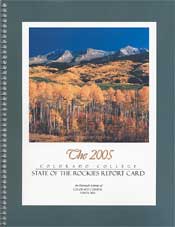
| State of the Rockies Extends Reach | |
| by Jane Turnis |
 The second annual State of the Rockies Conference and Report broadened its horizons this year, with greater attendance, greater reach, and a greater sense of purpose and place.
The second annual State of the Rockies Conference and Report broadened its horizons this year, with greater attendance, greater reach, and a greater sense of purpose and place.
Professor Walt Hecox ’64, who organized the conference, mused afterward, “CC is gaining regional and national recognition for tackling significant and vital issues in our eight-state Rockies backyard. My proudest moments came when CC students and alumni spoke to the conference about their research: Christie Renner ’05 about the expanding Great Sand Dunes National Park, Bryan Hurlbutt ’04 about the gateway community of West Yellowstone, and Patrick Holmes ’03 about sprawl, national parks, and creative occupations in the Rockies.”
The conference, held April 5-7, sparked discussion, debate, and discourse, much of it around the unveiling of the 2005 State of the Rockies Report Card,
this year an impressive 113-page publication filled with research and reports by
students and visiting researchers who focused on issues and assessments including:





Photos courtesy of photos.com
- National Parks Under Stress
- Rockies Energy Futures
- The Toxic Rockies
- Rockies Sprawl Index
- Native American Tribes Regaining Sovereignty
- Creative Occupations Patterns
- Civic Engagement and Capacity
The conference, which drew more than 2,100 people to various events, featured some of the nation’s top energy-issues experts, including New Mexico Gov. Bill Richardson, a former U.S. energy secretary; Amory Lovins, alternative-fuels guru and chief executive officer of the Rocky Mountain Institute; and Matt Simmons, president of Simmons & Company International, an independent investment bank specializing in the energy industry.
Stories of Native Americans recapturing control over their lives, communities, tribal lands, and heritage were shared during a panel discussion:
- The Southern Utes in Colorado establishing the Southern Ute Academy, which will teach the tribe’s language; as the mother of one student stated, “When you lose your language, you lose yourself.”
- Northern New Mexico’s Taos Pueblo recovering Blue Lake, considered the source of their creation, to make it available exclusively for tribal use.
- The Confederated Salish and Kootenai Tribes in Montana gaining significant management responsibilities for the National Bison Range.
Patricia Limerick, professor of history and environmental studies and faculty director of the Center of the American West at the University of Colorado-Boulder, held a full Gates Common Room in thrall in a hilarious speech that illustrated her attempts to myth-bust in the West — and how she often loses the fight to the less realistic Western lore of Louis L’Amour and others.
Author and environmentalist Terry Tempest Williams capped the conference with a moving talk that challenged listeners to look beyond the black and white, to seek out nuance, empathy, and positive change. It was a fitting ending to a conference and annual report that got hundreds of people discussing ways to make the Rockies region healthier, its people more engaged, and its communities better prepared to treat the fragile region in a way that will keep its spectacular qualities just that — spectacular.
For more information about the State of the Rockies Report Card and Conference, or to order a copy of the report, go to www.ColoradoCollege.edu/StateoftheRockies. The next conference is tentatively scheduled for April 10-14, 2006.